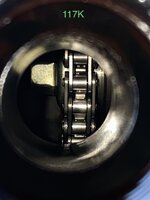found this:
" What is causing the failures?
This is not down to a design problem, or a mechanical problem with the engine as such but more down to “long-life” servicing which can lead to oil changes occurring every 20,000 miles.
Combine this type of servicing with cars which have missed a service, gone overdue on a service, or even gone to a non-specialist garage where an incorrect oil grade is used during the service, and the result can be catastrophic.
The problem is the engine oil. Engine oil is not only designed to lubricate moving parts it is also used to control temperatures inside the engine, for example by cooling pistons, but also to absorb carbon. Carbon is by-product of combustion and occurs both in petrol and diesel engines.
As soon as you put new oil into an engine it is absorbing carbon from the moment you start the engine, when the oil is new this is not a problem the carbon is absorbed effectively and the car operates as normal. When the engine oil is “used” and has maybe done 10,000 miles + it becomes less effective, when the oil has done 15,000 + miles the oil can no longer absorb the carbon as it should and it starts to solidify or “sludge up” / “coke up” .This sludge then sticks to important engine components and can begin to block oil galleries and oil pumps.
Once oil pumps, and galleries begin to block up, key components begin to get starved of oil, this can quickely lead to permanent damage and failure, often resulting in expensive repairs.
Although we have not have engine seizures with these models we have experienced problems with the Variable camshaft timing ( know as VANOS ) Variable Valve Lift ( Valvetronic ) and the timing chains – all of which can be attributed to poor oil quality or coking up ( Where the oil has begun to turn to sludge ) "

bmautomotivesolutions.co.uk



